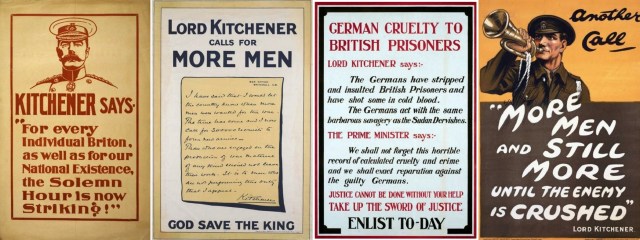The most famous image of the Great War was originally designed as a magazine cover. Bet you didn’t know that.
Designed by Alfred Leete – this is his original drawing in graphite and black & white paint – it graced the cover of ‘London Opinion’ on 5th September 1914, as you’ve just seen, still in glorious black & white, and presaged the government’s use of the image in a recruitment campaign that has been credited with persuading some two million men to enlist during the first eighteen months of the war, a million of them by the close of 1914.
Hardly surprising that the image propelled Kitchener into what we would today call superstardom, his face known throughout the world, as seen in these recruitment campaigns from Canada & South Africa.
Equally unsurprising that he would feature on a range of recruitment propaganda in the days before conscription back at home, both popular,…
…and official.
Nonetheless, despite the success of the early recruitment campaign, as the summer months of 1915 passed, and with British losses increasing and the numbers of men enlisting falling, by autumn the government was discussing the question of conscription in earnest.
The argument in parliament was hard-fought on both sides, but there was really no option; men were needed, or the war would be lost. Last man standing and all that. And he wouldn’t be British.
And so, in late January 1916, the Military Service Act was passed,…
…and for those of you who have never read it,…
…although do tell me otherwise,…
…you’ve probably just skipped another opportunity. Luckily, here’s a poster that précised the main points:
Five weeks later, on 2nd March 1916, the Military Service Act 1916 would become law in Great Britain, and you were either conscripted, excepted, exempted, or possibly exempted, depending on the decision of a local tribunal.
In those five weeks, numerous leaflets were printed, informing the general public of the forthcoming law…
…and what they should, or could, do about it.
…and here, a reminder that Certificates of Exemption (below) had to be applied for by the day the Act became law.
So, on the face of it, all fairly straightforward, really. Which, rather than Lord Kitchener, is actually the point of this post. Because this was far from the case in one particular Commonwealth country, where the issue of conscription created a bitter and heated debate, as we shall see over the next two posts.




















Ah it reminds of teaching days and the necessity of the bairns knowing about this Act. How could government walk away after so many had already died? We looked at a lot of posters too so I am looking forward to the rest of this series. Some tartan ones as Scots also were targeted? Not sure if any were in Gaelic though
Crikey! That means you’ve read it! Gold Star! Must read it meself one day………lol! There are indeed some great Scottish recruitment posters. Kilts galore (as there were in some Canadian posters too, of course). However the hoops involved in getting permission to show them etc etc can be a problem, so I wouldn’t hold your breath on that one, I’m afraid. I don’t have time for hoops. And anyway, we leave these shores for the next two installments. Sorry to be a disappointment……(insert winky face here).
The information leaflets in this post are mainly from the IWM archive, and are only in English & Welsh – I could find no Gaelic ones when I looked.